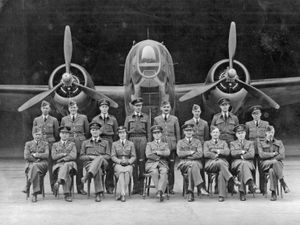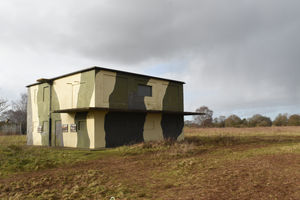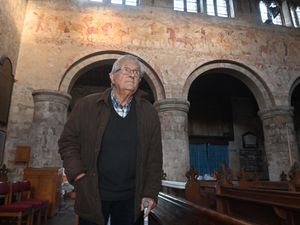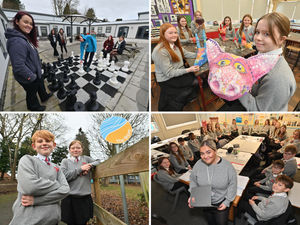VE Day 2025: A family's fascinating link with a Shropshire airbase has inspired generations
Fascinating family link with Shropshire airfield has echoed down the generations
A thread of history connects our wartime photo of personnel at a Shropshire air base with today's commemorations of the 80th anniversary of the end of World War II in Europe.
During the conflict tens of thousands of men and women from all over Britain, and indeed, from all corners of the world, came to the county during their service.
Among them was Alistair Logan, who is seated on the front row, second from right, whose granddaughter Kitty Logan is a freelance TV news reporter, producer, and filmmaker, who came to Shropshire to film a piece being broadcast as part of the current VE Day remembrance.
Alistair served for a time at RAF Tern Hill, which during his spell there was a front-line operational air base from which fighters took off to intercept Nazi raiders, and was also badly bombed into the bargain.
He lived in officers' quarters with his wife and three young sons at Sandford Hall, near Prees Heath. Kitty's father was born there in 1941, and the childhood memories of her uncle John Logan, who is now 90, sparked her fascination with her family's local connection, spurring her to visit the old airfield at Prees Heath, which was known as RAF Tilstock, a number of times.
Her latest visit was as an independent producer on commission for CGTN Europe to film a feature news piece to mark the 80th anniversary of VE Day. Kitty has also written the story for British Forces Broadcasting Service News.

"I first stood on one of the aircraft turning circles which were once part of Tilstock airfield without realising," she said.
"I had parked my car there on the way to film an unrelated story about a charity called ‘Nature’s Safe’. It was only months later while visiting my uncle in Sussex, that I became aware of the history of the airfield and the family connection to the area. I then became fascinated with learning more about it.
"My uncle, John Logan, now 90 years old, has clear childhood memories of Prees Heath, including witnessing the construction of RAF Tilstock and recalling a bomber flying so low overhead he could see the pilot waving.
"John was born in Richmond, London, and like many children in the capital he was evacuated during the war.
"The family was sent to Shropshire when he was around seven years old, while my grandfather, Alistair Logan, served as a Flight Lieutenant at RAF Tern Hill in a maintenance unit. There were allocated officers’ quarters at Sandford Hall, where my father was born in 1941. The house, now a listed building, was less glamorous than at first sight – freezing in winter with no running water.
"But for John, who lived in wartime Shropshire for around two years, the experience of evacuation and exploring the extensive grounds of Sandford Hall was, somewhat surprisingly, an exciting adventure. He relished in the days without school and rode around the local countryside on a borrowed bike, enjoying the near-empty roads.
"He caught moles, selling the skins for extra cash (moleskins were then used to make purses), he learned to fish and worked on a nearby mushroom farm as part of the war effort, driving a tractor when he was only nine years old.
"My grandfather never spoke of his time at Tern Hill. A businessman before the war, all we know is that he served in the RAF as an accountant.
"A chauffeur-driven CEO in later life, he never learned to drive - and so he most certainly did not fly planes. It is unlikely he even fired a gun during the war, although it is possible he came under fire during his deployment at Tern Hill during a bombing raid.
"He was eventually posted back to HQ in London in another administrative role.
"However, for John, the wartime years in Shropshire shaped his future. To my grandfather’s dismay, despite paying for one of the most expensive schools in London to encourage his son to become a doctor, John instead left school at 16 to become a farm hand, eventually studying agriculture and buying his own small farm in East Sussex.
"To this day, he credits his childhood in rural Shropshire and the resourcefulness he learned during the war as the key inspiration to live off the land and stay close to nature for the rest of his life.
"Inspired by John’s story, I returned to Tilstock airfield several times to find out more, firstly in a personal capacity. Tullis Matson, the Director of Nature’s Safe, kindly hosted me on a tour of the area, showing me the derelict barracks and hidden bunkers in the woods.
"His office sits on the edge of the airfield, where his family farmed land generations, so he has a wealth of knowledge about the history."
Kitty added: "It has been an incredible time learning about Shropshire’s airfields, which of course resonates more now as we mark the 80th anniversary of VE day.
"I am enormously thankful to all the people I have met while exploring Tilstock airfield – Tullis Matson at Nature’s Safe, the team at Skydive Tilstock and the dedicated staff at Whitchurch Museum and Archives especially."
Kitty's grandfather Alistair died in 1997 at the age of 94.

The old RAF Tilstock is today one of the most familiar airfields, as the busy A41 roads runs across the middle of the site just south of Whitchurch, and the former control tower still stands, albeit now converted to a roost. During the war the airfield was used for heavy bomber training and also glider towing training.
As for the picture taken at RAF Tern Hill featuring Alistair, the personnel are posing in front of an American-made plane, although we'll have to leave it to wartime plane recognition experts to determine whether it's a Lockheed Hudson or the very similar Lockheed Ventura.





